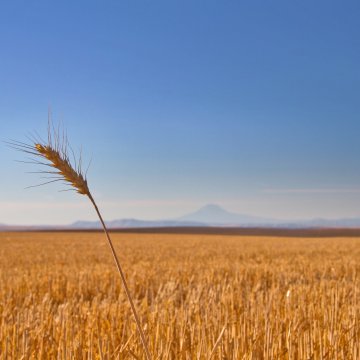
1. Wheat Futures Decline on Improved French Outlook
Wheat futures fell in overnight trading on an improved outlook for crops in Europe while corn and beans were modestly higher.
French stockpiles at the end of the 2020-2021 marketing year are now seen by national consultancy FranceAgriMer at 2.7 million metric tons, an increase of 100,000 tons from its previous outlook.
Warm weather last week improved soft-wheat conditions in France, which were rated 88% good to very good, according to a report from the Agriculture and Horticulture Development Board in England.
The U.S. Department of Agriculture raised its outlook for global wheat production to 776.8 million metric tons from 773.4 million tons in its monthly World Agricultural Supply and Demand Estimates (WASDE) report on Tuesday.
Exports are projected at 197.7 million metric tons, up from 194.8 million expected last month, the USDA said.
Shipments from the U.S. are seen at 22.8 million metric tons, unchanged month-to-month.
The USDA increased its outlook for Canadian exports to 27 million metric tons from 26.5 million in January. Australian exports are pegged at 22 million metric tons, up from 20 million a month earlier, the agency said.
Russian exports were seen at 39 million metric tons, unchanged from the previous forecast.
Soybeans were slightly higher after Argentina’s Rosario Grains Exchange cut its production outlook for the South American country by 8.1% to 45 million metric tons due to dry weather.
“Argentina double-crop soy (about 30% of all soy) losses continue this week due to extensive dryness,” Commodity Weather Group said in a report.
Wheat futures for May delivery fell 5¢ to $6.47½ a bushel overnight on the Chicago Board of Trade, while Kansas City futures lost 6¢ to $6.10½ a bushel.
Soybean futures for May delivery rose 1¾¢ to $14.11½ a bushel. Soymeal 10¢ to $406.70 a short ton, and soy oil rose 0.25¢ to 53.76¢ a pound.
Corn gained 2½¢ to $5.36½ a bushel in overnight trading.
** **2. Ethanol Production Increases to Highest Since Mid-January
Ethanol output jumped to the highest level in almost two months while inventories declined, according to the Energy Information Administration.
Production of the biofuel rose to an average of 938,000 barrels a day in the week that ended on March 5, the EIA said in a report.
That’s up from 849,000 barrels a day, on average, the previous week and the highest level since the seven days that ended on Jan. 15, government data show.
In the Midwest, by far the biggest producing region, production rose to 894,000 barrels a day from 811,000 barrels a week earlier. That’s the highest level in a month.
East Coast output improved to an average of 12,000 barrels a day from 11,000 the previous week, and Gulf Coast production increased to 14,000 barrels a day from 10,000, the agency said.
Rocky Mountain production was up to 10,000 barrels a day from 9,000, and West Coast output was unchanged at 9,000 barrels a day, on average.
Stockpiles, meanwhile, dropped to the lowest level in more than two months.
Ethanol inventories fell to 22.07 million barrels in the week through March 5, down from 22.425 million seven days earlier.
That’s the lowest level since the seven days that ended on Nov. 27, the EIA said in its report.
**
3. Winter Storm Warnings Still in Effect in Northern Minnesota
Winter storm warnings and advisories are still in effect in parts of northern Minnesota and Wisconsin this morning while flood watches have been issued in parts of Kansas, Missouri, and Illinois, according to the National Weather Service.
In the northeastern quarter of Minnesota, heavy snow will continue through about 9 a.m. local time along with winds gusting to about 35 mph, the NWS said in a report early this morning.
Roads are expected to be slick.
Farther south, flood watches have been issued for counties in southern Kansas, southern Missouri, and southern Illinois.
The Bourbon, Cherokee, and Crawford regions in Kansas and several areas including Barry, Cedar, Jasper, Ozark, and Wright in Missouri will be affected.
Several rounds of precipitation are expected starting late this afternoon and lasting through Saturday, the agency said.
“Excessive rainfall is expected over the next several days,” the NWS said. “With the lack of vegetation coming off the winter, runoff will lead to flooding of small streams, creeks, and some main stem rivers. Flooded low water crossings will become common through weeks end and into early next week.”








 User Center
User Center My Training Class
My Training Class Feedback
Feedback












Comments
Something to say?
Log in or Sign up for free